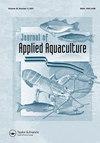Phytase supplemented diets do not reduce the abundance of cyanobacteria and common off-flavor compounds in hybrid striped bass (Morone chrysops x M. saxatilis) aquaculture ponds
IF 0.8
Q3 FISHERIES
引用次数: 0
Abstract
ABSTRACT Freshwater fish grown in earthen ponds in the southeastern US can acquire “earthy” and “musty” taints due to the bioaccumulation of the cyanobacteria metabolites geosmin and 2-methyisoborneol (MIB) in the fish flesh and result in unmarketable fish. Dense cyanobacteria communities occur because nutrient inputs (phosphorus) are high in fish production ponds due to high feed application rates. In this study, hybrid striped bass (Morone chrysops x M. saxatilis) grown in earthen ponds was offered one of the six diets including diets supplemented with phytase to reduce phosphorus input to the pond and the subsequent intention of reducing the abundance of undesirable cyanobacteria. Water samples collected biweekly from each pond were analyzed for phytoplankton community structure and concentrations of geosmin and MIB. Differences in dietary phosphorus consumption among diets did not significantly affect soluble reactive phosphorus and total phosphorus concentrations, cyanobacteria abundance, and geosmin and MIB concentrations in pond water.补充植酸酶的日粮不会降低杂交带鱼(Morone chrysops x M. saxatilis)养殖池塘中蓝藻和常见异味化合物的丰度
摘要 美国东南部土池中养殖的淡水鱼会因蓝藻代谢物地奥司明和 2-甲基异龙脑(MIB)在鱼肉中的生物累积而产生 "土腥味 "和 "霉味",导致鱼无法上市销售。蓝藻群落密集的原因是,鱼类生产池塘的饲料投喂率较高,导致营养物质(磷)摄入量较高。在这项研究中,为土池中养殖的杂交带鱼(Morone chrysops x M. saxatilis)提供了六种日粮中的一种,其中包括添加植酸酶的日粮,以减少池塘中的磷投入量,进而减少不良蓝藻的数量。每两周从每个池塘收集一次水样,分析浮游植物群落结构以及地衣素和 MIB 的浓度。不同膳食中磷摄入量的差异对池塘水中可溶性活性磷和总磷浓度、蓝藻丰度以及地衣素和 MIB 浓度没有显著影响。
本文章由计算机程序翻译,如有差异,请以英文原文为准。
求助全文
约1分钟内获得全文
求助全文
来源期刊

Journal of Applied Aquaculture
Environmental Science-Ecology
CiteScore
3.20
自引率
0.00%
发文量
38
期刊介绍:
The Journal of Applied Aquaculture is a platform for the sharing of practical information needed by researchers to meet the needs of investors, farm managers, extension agents and policy makers working to adapt aquaculture theory to achieve economic and food security objectives in the real world. The journal emphasizes multi-disciplinary research and case studies that propose financially and logistically viable solutions to observable problems.
 求助内容:
求助内容: 应助结果提醒方式:
应助结果提醒方式:


